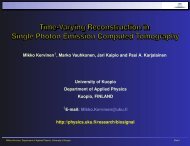Karjalainen, Pasi A. Regularization and Bayesian methods for ...
Karjalainen, Pasi A. Regularization and Bayesian methods for ...
Karjalainen, Pasi A. Regularization and Bayesian methods for ...
You also want an ePaper? Increase the reach of your titles
YUMPU automatically turns print PDFs into web optimized ePapers that Google loves.
36 2. Estimation theory<br />
Note, that the criterion (2.172) implies that the residual r = z −ẑ = z −H ˆθ LS<br />
is orthogonal to all columns of the matrix H. In other words, r belongs to the null<br />
space of H T that equals to the orthogonal complement of the range of H, that<br />
is r ∈ N ( H ) T = R (H) ⊥ . By definition ẑ ∈ R (H) <strong>and</strong> dim (R (H)) = p. The<br />
measurement z ∈ R M is now of the <strong>for</strong>m<br />
z = ẑ + r (2.175)<br />
<strong>and</strong> we can see that ẑ is the orthogonal projection of z onto R (H), the linear<br />
subspace spanned by the columns of the matrix H. We call these vectors the basis<br />
vectors. This interpretation of the least squares problem is central in Chapter 6.<br />
The generalized solution is obtained by multiplying the equation (2.167) with<br />
a matrix L so that L T L = W<br />
<strong>and</strong> with notations z ′ = Lz <strong>and</strong> H ′ = LH<br />
Now the minimization of the generalized index<br />
is obtained by using (2.174)<br />
Lz = LHθ + Lv (2.176)<br />
z ′ = H ′ θ + Lv (2.177)<br />
l GLS = (z − Hθ)W(z − Hθ) T (2.178)<br />
= (z ′ − H ′ θ)(z ′ − H ′ θ) T (2.179)<br />
ˆθ GLS = (H ′T H ′ ) −1 H ′T z ′ (2.180)<br />
= (H T L T LH) −1 H T L T Lz (2.181)<br />
= (H T WH) −1 H T Wz (2.182)<br />
This is seen to be equivalent to the Gauss–Markov estimate ˆθ GM if we choose<br />
W = Cv −1 .<br />
A classical reference <strong>for</strong> linear <strong>and</strong> nonlinear least squares problems is [110]<br />
<strong>and</strong> <strong>for</strong> nonlinear optimization in general [93].<br />
2.13 Comparison of ML, MAP <strong>and</strong> MS estimates<br />
In this section we compare the maximum likelihood estimation with maximum a<br />
posteriori estimation in case of Gaussian densities. Let the observation model be<br />
z = h(θ) + v (2.183)<br />
where θ <strong>and</strong> v are r<strong>and</strong>om parameters. Only the parameters θ are to be estimated.<br />
Given θ, the observations z <strong>and</strong> the error v have the same density, except that the<br />
mean E {z} = E {v} + h(θ). The density of z given θ is thus<br />
p(z|θ) = p v (z − h(θ)|θ) (2.184)





